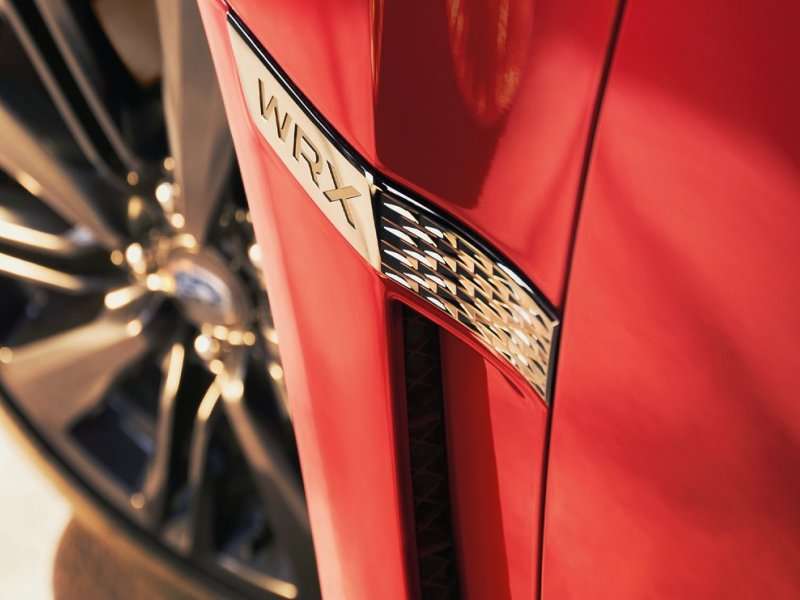Recent Articles
Popular Makes
Body Types
2015 Subaru WRX Quick Spin
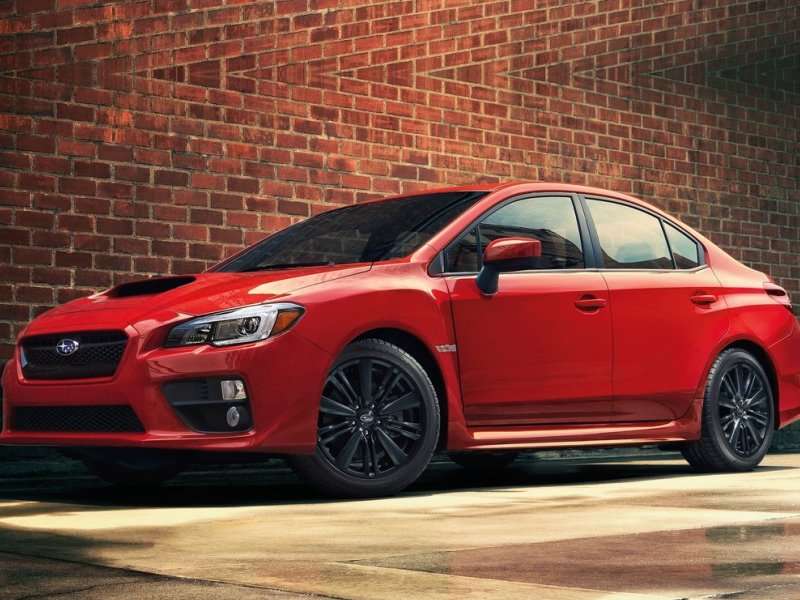
We all have to grow up sometime, and such is the case for the 2015 Subaru WRX.
Now a model line unto itself, for the 2015 model year, Subaru has dropped mention of the Impreza nameplate—the root from which the model is derived. The car is now simply known as the 2015 Subaru WRX. With that said, the maturation of the WRX is highly apparent in other ways as well.
The look of the car is more “adult” now. Which is to say, the WRX is still very potent looking, albeit considerably less flamboyant about it than the previous iteration of the Subaru. The hatchback option is no more; the only body for the WRX going forward will be the four-door sedan. A continuously variable automatic transmission is part of the package now, and the interior treatment has a newfound air of style and quality.
And, while the original WRX models were more of paean to Subaru’s World Rally heritage, making the car feel more at home on rough, uneven surfaces than pavement, this new model has been engineered to be the best-handling WRX ever on pavement.
A clean-sheet design, every major system responsible for making the 2015 Subaru WRX accelerate, corner, steer, and stop is new and improved. Now, for the record, while we’ve placed a lot of emphasis on the maturation of the 2015 Subaru WRX, please know, when it comes to performance, the all-new Subaru WRX is just as youthful as it ever was. It simply goes about handling its business in a significantly more polished and sophisticated manner now.
2015 Subaru WRX Quick Spin: Styling
The WRX now looks more like a European sport sedan than the thinly disguised boy-racing machine it previously resembled. The gold wheels are gone, replaced by black ones, the big rear wing is gone, replaced by a subtle tail spoiler, and the huge hood scoop has been toned down considerably. In sum, the 2015 Subaru WRX simply looks cleaner.
The front end employs a nosecone design with a deep front spoiler and a unique grille. The foglights are positioned down low and at the corners for a more aggressive appearance. The “A” pillars are more sleek and raked farther forward, giving the car a “faster” overall appearance. Very definite cutlines for the fenders give the WRX a nicely planted look, while also adding substance to the design. Deep side skirts help with aerodynamics and further the visual impression the car is glued to the ground.
While the basis of the design is indeed derived from the Impreza, only the roof and the rear decklid of the WRX are identical to the Impreza. The doors, front fenders, hood, bumpers, headlights and taillight clusters are all specific to the WRX. So while you might see a hint of Impreza in the overall shape of the car, the unique detailing of the WRX really does make it look quite distinctive from its more sedate cousin.
If you take a close look at the front end, you’ll also see hints of the Viper. This is somewhat intentional as the design team was going for the look of a raptor. This is most apparent in the shape of the headlights and the way their positioning mimics the way a snake’s eyes are more on the sides of its head than the front. The all-new 17-inch wheels incorporate an aerodynamic design to reduce drag and improve brake cooling. Completing the look of the 2015 Subaru WRX are a set of LED taillights, a rear diffuser beneath the bumper, a LED center high-mount stop lamp, and an optional lip spoiler for the trunklid.
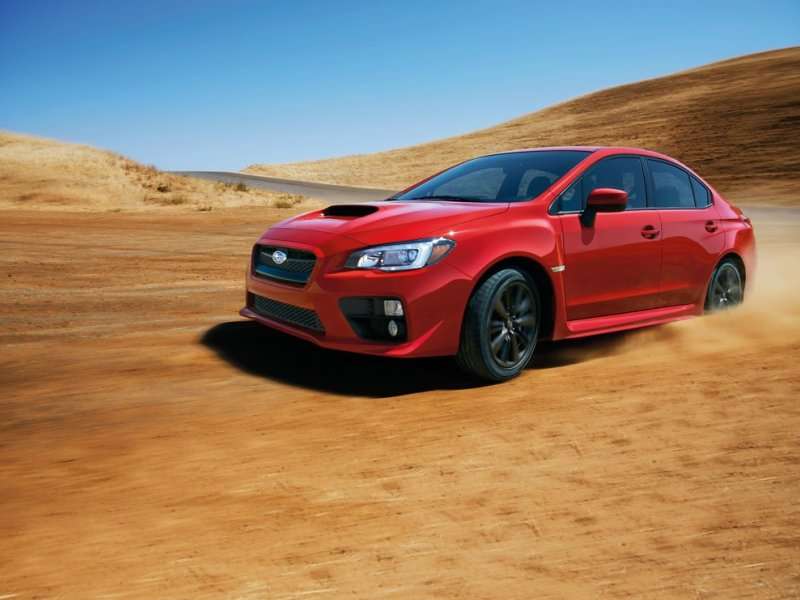
2015 Subaru WRX Quick Spin: Interior
As soon as you settle into the well-bolstered driver’s sport seat, you’ll immediately know this is a car designed to be driven with enthusiasm. The rim of the D-shaped steering wheel is endowed with considerable girth. It feels quite substantial in your hands and affords a considerable amount of both control and comfort—particularly over long drives. Yes, its overall appearance is a bit clichéd, but the cliché exists only because it’s the absolute best solution. Buttons on the steering wheel offer control over the audio system, cruise control, and for CVT equipped versions of the 2015 WRX, the Subaru Intelligent Drive (SI-DRIVE) system (more on that later in this report).
Two large round dials dominate the instrument panel, housing 3D looking gauges. The larger readouts in them are predictably the tachometer for engine speed and the speedometer for road speed. Their orange on black color scheme works really well for the two larger gauges, but we found the fuel gauge and temperature gauge took more than a cursory glance to offer an accurate assessment. In other words, we had to look at those instruments to gauge their levels, rather than giving them just a quick skim and immediately deciphering their information.
Between the two large dials is a 3.5-inch LCD multifunction display for the trip computer information, oil level, washer fluid level, and gear ratio. To the right of the instrument cluster, positioned atop the dash, is another LCD monitor; this one provides a rear camera display, a boost gauge display, audio, Bluetooth, climate control settings, and a VDC screen showing traction control operation. The display can also provide a vehicle self-check and maintenance reminders.
If the optional navigation system is ordered, the WRX gets another monitor in its center console where the radio is situated in cars not equipped with navigation.
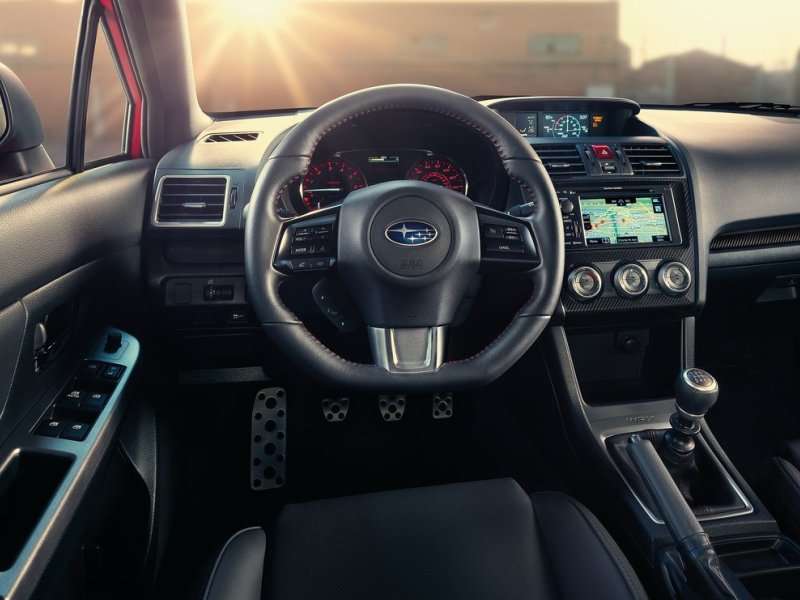
2015 Subaru WRX Quick Spin: Comfort and Cargo
Compared to the outgoing WRX, the interior is considerably more spacious. Those faster "A" pillars pull the windshield forward more, so the Subaru feels even roomier than it actually is. The dash is positioned lower too, which also contributes to the more airy feel of the passenger compartment. While we’re on the subject of spaciousness, there is approximately two more inches of legroom in the back seat than before.
Subaru has switched to a three-piece design for the front seats, employing a separate headrest for more flexibility and adaptability to a wider variety of body types. Upper trim levels get leather upholstery and an eight-way electrically adjustable driver’s seat.
An automatic climate control system is standard equipment, as is a folding back seat coupled with a pass-through to expand cargo capacity from the confines of the 12 cubic feet of the trunk. Options include keyless entry and push-button start; along with heated front seats, the aforementioned power driver’s seat, a 440-watt, eight-channel, nine-speaker harman/kardon premium audio system, and navigation with Aha smartphone integration.
Contributing significantly to the newfound comfort of the interior is the generous usage of soft-touch materials for the dashboard, door trim, and center console armrest. There is an optional sunroof as well, which, BTW opens a full inch wider than the one fitted to the previous WRX. Also larger are the door openings to ease ingress and egress. Furthering this, the step-in height is lower than the previous model of the WRX.
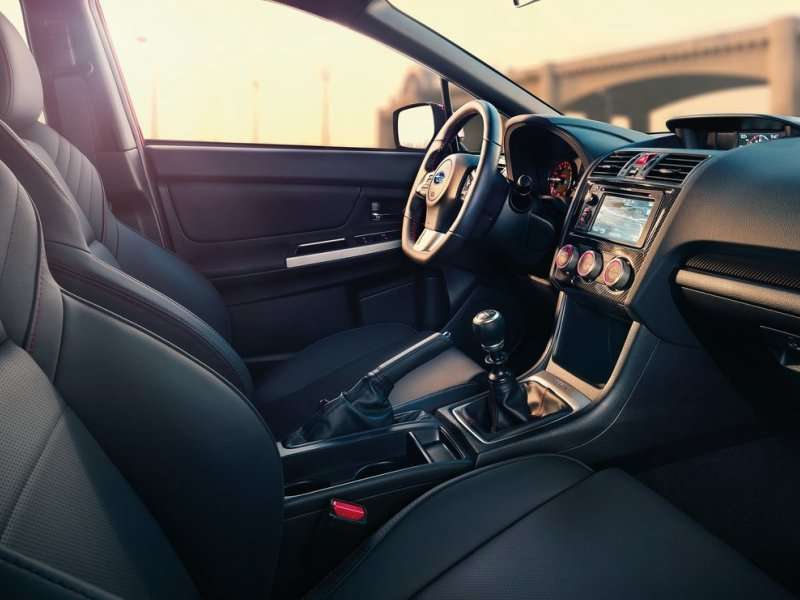
2015 Subaru WRX Quick Spin: Safety
Stability control, traction control, anti-lock brakes, a full complement of airbags, and of course Subaru’s all-wheel drive system are the safety highlights of the new WRX. Speaking of the airbags, a driver’s knee airbag is added to the front side pelvis/torso airbags and side curtain airbags for front and rear outboard seat coverage.
The seat backs of the front sport seats in the 2015 Subaru WRX employ an ”S” shape designed to deform when exposed to crash energy in order to settle the occupants more deeply into the seats so the restraint systems can operate more efficiently.
High-strength steel componentry, along with pre-determined crumple zones engineered to direct crash energy away from the people in the car are incorporated as well.
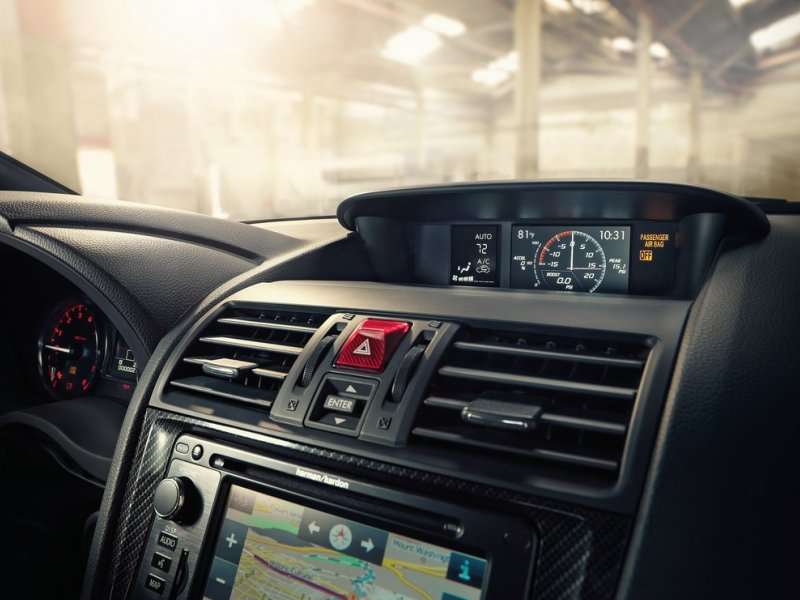
2015 Subaru WRX Quick Spin: Engine /Transmissions
A 2.0-liter direct injection turbocharged horizontally opposed four-cylinder engine with variable valve timing provides 268 horsepower and 258 ft-lbs of torque to the 2015 WRX. Peak torque occurs at just 2000 rpm.
A six-speed manual transmission replaces the five-speed unit housed in the previous generation WRX. Also new to the WRX is a continuously variable transmission (CVT). And while this might well sound like an anathema in regards to the mission of the WRX as a performance car, the reality is it works quite well. In fact, the way the transmission is calibrated, you’d be hard pressed to even discern it is even a continuously variable unit. By the way, in Subaru-speak the CVT is called “Sport Lineartronic”.
The engineering team programmed two manual modes (one with six preselected ratios and another with eight) into the CVT. These are employed using paddles mounted on the steering wheel. Designed to work with the SI-DRIVE system’s choice of three drive modes, the Sport Lineartronic transmission is also fitted with the capability of analyzing your driving style and responding accordingly.
Cars equipped with the six-speed manual transmission make do without SI-DRIVE, though they do get the Continuous AWD version of Subaru’s Symmetrical All-Wheel Drive system. With it, a viscous coupling locking center differential distributes torque 50:50 front to rear in steady state operation, with the Vehicle Dynamics Control (VDC) system providing stability and traction control. Should wheel spin become imminent, power is transferred to the wheels with the most traction.
The Sport Lineartronic transmission (the CVT) is paired with the Variable Torque Distribution (VTD) version of Subaru’s Symmetrical All-Wheel Drive. In this configuration, a planetary gear-type center differential and an electronically controlled hydraulic transfer clutch control torque distribution between the front and rear wheels. In steady-state operation, this system defaults to a 45:55 torque split. However, the VTD system also continually optimizes torque distribution in response to driving conditions and input from steering wheel angle, yaw, and lateral g-force sensors.
Both systems employ torque vectoring at the front wheels to improve cornering. When acceleration is applied mid-corner, the inside front wheel gets braking, while the outside front wheel gets more torque apportioned to it. This serves to make the car pivot more cleanly, thereby tightening the WRX’s line through a corner.
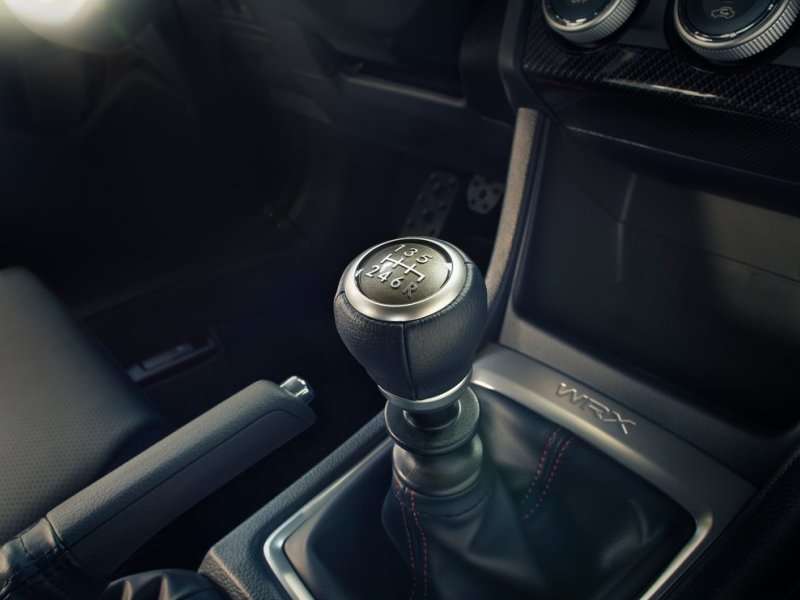
2015 Subaru WRX Quick Spin: Driving Impressions
Subaru quotes zero to 60 at 5.4 seconds with the six-speed manual and 5.9-seconds with the Sport Lineartronic transmission. In the real world, both feel adequately quick. What you notice more than anything else is the sharp throttle response, with both transmissions. This, also regardless of the drive mode you select with the CVT. There is hardly any play in the pedal at all, you push the gas pedal and the WRX responds immediately. Further, the engine winds freely, is very smooth in operation, and sounds wonderful—with just a hint of turbo whistle reminding you the engine is force-fed. That said, we experienced no turbo lag whatsoever, the engine simply spins up and goes.
The same goes for the steering; helm reaction is near instantaneous. The go-kart sensation everybody loves about the Mazda MX-5? Yeah, the WRX has it too, and the Subaru’s steering is also very linear in its response. Once you become accustomed to the quickness of it, you also recognize how very accurate it is. Subaru’s spokes-folk say the engineers benchmarked the Porsche 911 in this regard. And while the delightfully lively feel the 911 is famous for isn’t exactly there, the responsiveness of the 911’s steering most definitely is. This is all the more remarkable when one considers the WRX uses electrically assisted power steering.
The list of suspension improvements over the outgoing WRX is so extensive it’d take way more space than we have here to recount it entirely. Let’s just say everything that could be stiffened and reinforced to improve the handling of the car was duly upgraded. Body roll is practically non-existent. Subaru says the new WRX pulls .93g on the skidpad; we have every reason to believe this is true. The car turns into corners very nicely and grips resolutely.
Along with the improved power and additional grip, Subaru was obligated to improve the braking system. Larger rotors and more robust calipers provide fade-free operation—along with precise modulation.
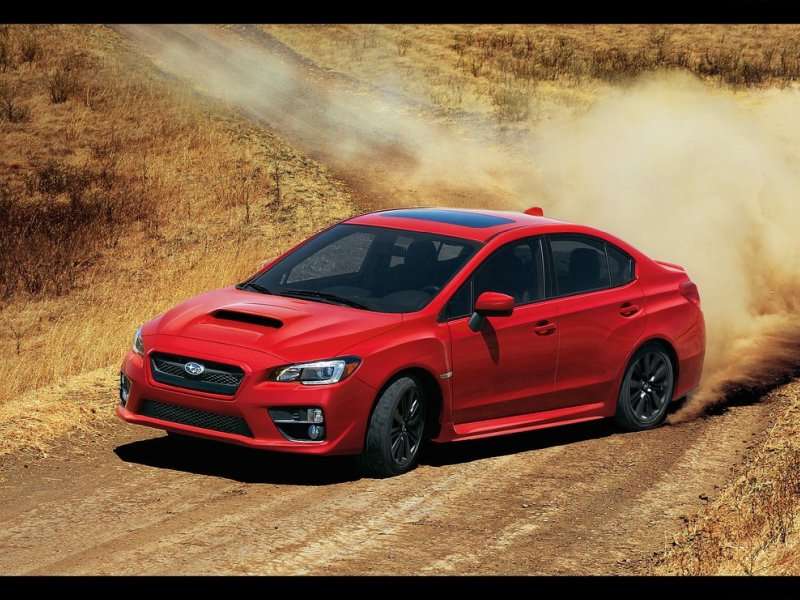
2015 Subaru WRX Quick Spin: Final Thoughts
Long story short, this is a car you’ll love driving because it does everything exactly the way it should. The slight dullness on pavement plaguing previous versions of the WRX owing to the compliance they inherited from their rallying heritage has been dispensed with. Perhaps recognizing the vast majority of WRX intenders spend more time on pavement than dirt, this version of the WRX is exceptionally sharp and highly capable on asphalt.
Further, the overall character of the car reflects significant attention to improved quality and style. The interior treatment is handsome and confers an air of substance, while the look of the exterior of the car is considerably more sophisticated. About the only complaint we can lodge against the new WRX is the amount of road noise filtering into the passenger compartment.
Aside from that though, Subaru has finally come up with a WRX a dad could drive without feeling like he’d stolen it from his kid. But, at the same time, the kid can feel good about driving it too because the WRX still looks exceptionally capable—which it is.
In other words, yes, we like it.
